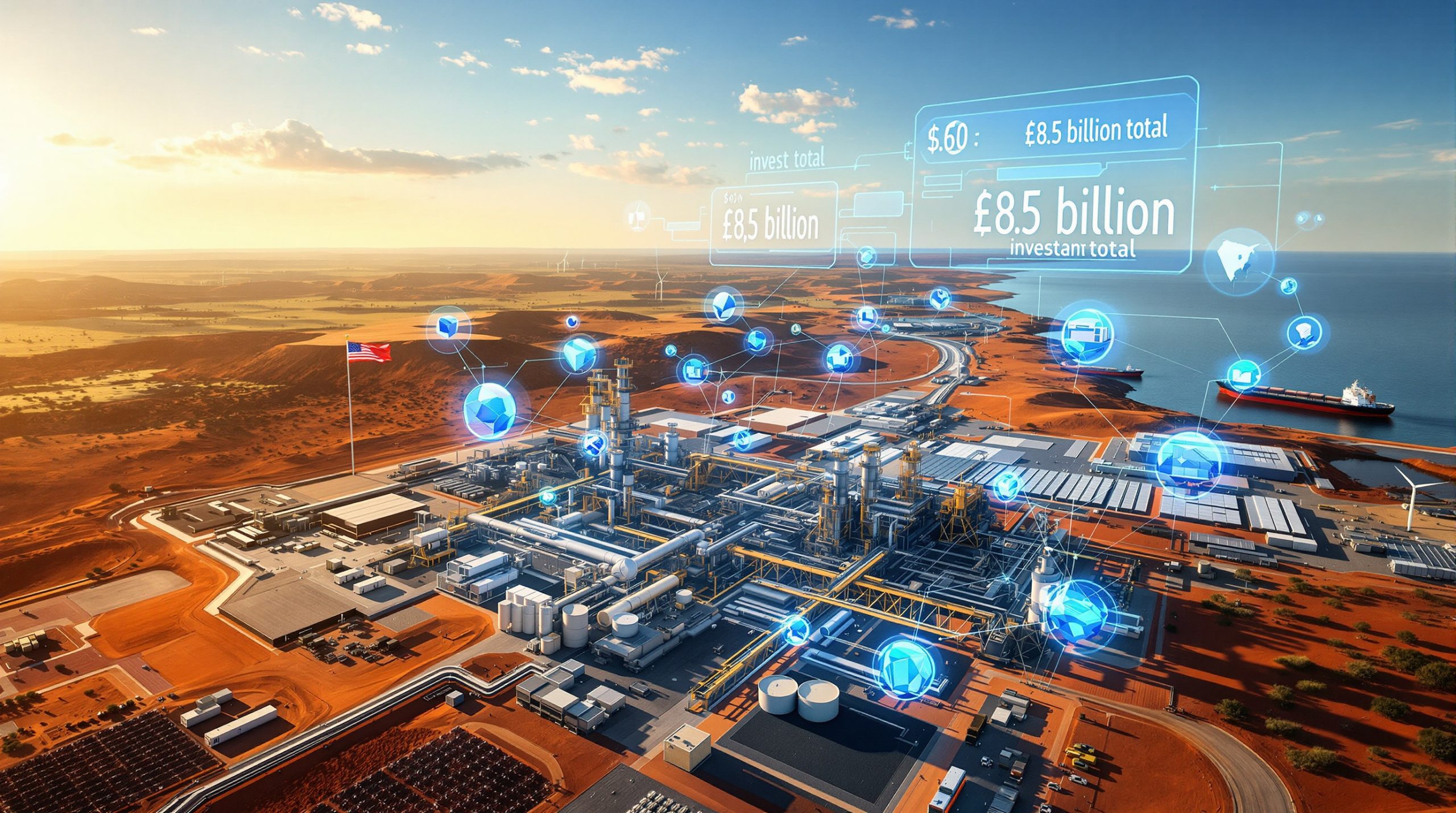Understanding Gallium's Strategic Role in Modern Technology
Gallium stands as one of the most critical elements driving the modern digital economy, yet remains largely invisible to most investors. This soft, silvery metal with a melting point of just 29.76°C has become indispensable for semiconductor manufacturing, advanced defense systems, and renewable energy infrastructure. The increasing focus on critical minerals energy transition has elevated gallium's strategic importance beyond its physical properties.
Global production currently hovers around 700 tonnes annually, with demand accelerating due to the semiconductor boom and military modernisation programs worldwide. China's dominance in refining capacity, controlling approximately 90-95% of global gallium processing, has created significant supply vulnerabilities that governments and corporations are scrambling to address.
Market analysts project substantial growth in gallium consumption over the next decade, driven by expanding applications in 5G infrastructure, electric vehicle components, and advanced radar systems. The global gallium market, valued at approximately USD 31.8 million in 2023, is projected to reach USD 45.2 million by 2030, though these figures likely understate the true strategic value of securing reliable supply chains.
Applications Driving Investment Interest
The semiconductor industry consumes 45-50% of global gallium production, primarily in the form of gallium arsenide compounds essential for high-frequency applications. These materials enable the advanced chips powering everything from smartphone amplifiers to satellite communications equipment. Military applications represent another 5-8% of consumption but carry disproportionate strategic weight, with gallium arsenide critical for radar systems in advanced fighter aircraft like the F-35.
LED manufacturing accounts for 35-40% of gallium usage, while emerging applications in solar photovoltaic cells represent a growing 5-10% market segment. Each F-35 fighter jet requires approximately 300-500 grams of gallium in various compound forms, highlighting how defence applications can create sustained demand despite relatively small volumes.
Australia's Emergence as a Gallium Investment Destination
Australia's transformation into a gallium investment hotspot reflects a convergence of geological advantages, political stability, and strategic partnerships that few other jurisdictions can match. The nation holds approximately 6,000 million tonnes of bauxite resources, representing roughly 20% of the world's economic bauxite reserves. Furthermore, Australia's leadership in developing sustainable bauxite project benefits demonstrates the country's commitment to responsible resource extraction.
The recent announcement of US$200 million in joint government investment from the United States and Australia represents a watershed moment for the sector. This funding supports Alcoa Corporation's gallium project in Western Australia, expected to produce 100 tonnes annually and supply approximately 10% of global gallium production. The project's trilateral structure, involving Japan's Sojitz Corporation, demonstrates how allied nations are collaborating to reduce dependency on Chinese supply chains.
Government Policy Framework Supporting Investment
Australia's Critical Minerals Strategy 2023-2030 identifies gallium among 31 critical minerals where the nation possesses competitive advantages. The Australian Government's Critical Minerals Facility has allocated AUD 2 billion for project financing, while streamlined approval processes through the Major Projects Facilitation Agency have reduced assessment times from 24-36 months to 12-18 months.
This policy support extends beyond domestic initiatives. The recent critical minerals order has reinforced bilateral cooperation between Australia and the United States. The US-Australia critical minerals partnership commits an initial US$1 billion over six months, with a broader pipeline of projects valued at US$8.5 billion.
Strategic Resource Advantages
Australia's bauxite contains gallium concentrations typically ranging from 40-80 parts per million, comparable to global averages but benefiting from large-scale, low-cost extraction methods. Western Australia's alumina refineries process approximately 12-15 million tonnes of bauxite annually, containing an estimated 500-1,200 tonnes of gallium that currently goes unrecovered.
The co-location advantage cannot be overstated. Retrofitting existing alumina refineries for gallium recovery reduces capital expenditure by 30-40% compared to standalone operations and cuts development timelines by 18-24 months. Alcoa's Pinjarra, Kwinana, and Wagerup refineries process approximately 4.8 million tonnes of alumina annually, providing a proven platform for gallium extraction implementation.
Investment Return Mechanisms in Gallium Projects
Gallium project investment in Australia operates through distinct revenue models that differentiate these opportunities from traditional mining investments. Unlike minerals sold primarily on spot markets, gallium transactions typically occur through long-term offtake agreements spanning 7-10 years with foundation customers from semiconductor, defence, and technology sectors.
Revenue Structure Analysis
The market reaction to Alcoa's government backing demonstrates investor appetite for gallium exposure. Alcoa shares surged 9.1% to $60.60 on announcement day, adding significant value to the company's $14.4 billion market capitalisation. This immediate market response reflects recognition of gallium's strategic value and the de-risking effect of government participation.
Primary revenue drivers include:
- Contracted offtake agreements with 5-10 year terms providing revenue stability
- Spot market sales capturing premium pricing during supply shortages
- Byproduct credits from integrated aluminium production reducing cash costs
- Strategic stockpiling agreements with government entities offering volume certainty
Revenue models typically secure 70-80% of production under long-term contracts before reaching financial investment decision. In addition, high-purity semiconductor-grade gallium commands 30-50% premiums over standard grades, while integrated operations benefit from zero raw material costs as gallium is recovered from existing process streams.
Investment Risk Assessment
| Risk Category | Impact Level | Primary Mitigation Strategies |
|---|---|---|
| Market Demand Volatility | Medium | Diversified application base across semiconductors, defence, LED manufacturing |
| Price Fluctuations | High | Long-term contract structures with escalation clauses, government offtake |
| Technical Complexity | Medium | Proven extraction technologies, experienced operator partnerships |
| Regulatory Changes | Low | Stable mining jurisdiction, critical minerals classification |
| Geopolitical Supply Disruption | High | Allied nation partnerships, supply chain diversification mandate |
China's export restrictions implemented in August 2023 resulted in immediate 15-20% price increases and sustained elevated pricing 25-30% above 2022 levels throughout 2024. This pricing environment has increased end-user willingness to commit to long-term contracts with non-Chinese suppliers at premium pricing, enhancing project economics for Australian operations.
Technical Infrastructure and Production Requirements
Commercial gallium production requires sophisticated technical infrastructure capable of achieving the purity levels demanded by end-use applications. Semiconductor-grade gallium must reach 99.9999% to 99.99999% purity (6N to 7N), while LED applications require 99.999% purity (5N). These stringent requirements necessitate multi-stage purification processes and extensive quality control systems.
Extraction Process Integration
Gallium recovery from the Bayer process involves extraction from sodium aluminate liquor during bauxite digestion, followed by concentration through fractional precipitation or solvent extraction. The evolving mining industry innovation continues to enhance these processes. The Alcoa-Sojitz project utilises enhanced liquid-liquid extraction technology optimised for their specific Bayer process chemistry, achieving 99.9999% purity required for semiconductor applications.
Recovery efficiency from Bayer process liquor typically ranges from 70-85% depending on technology employed, with final purification yields of 95-98%. For a 100-tonne per year facility like the Alcoa project, infrastructure requirements include:
- 2,000-3,000 square metres for extraction circuits
- 1,500-2,000 square metres for purification facilities
- 500-800 square metres for quality control laboratories
- 5-8 MW electrical power requirement
- Waste treatment capacity for 10,000-15,000 tonnes annually
Workforce and Operational Scaling
Commercial gallium operations require specialised technical expertise across multiple disciplines. A 100-tonne annual capacity facility typically employs:
- 8-12 chemical engineers for process optimisation
- 25-35 process operators across shift rotations
- 4-6 metallurgists for quality assurance
- 6-8 quality control specialists for purity verification
- 10-15 maintenance technicians for equipment reliability
Australia's established aluminium industry provides access to skilled personnel familiar with Bayer process operations, reducing training requirements and operational risk. The integration with existing refineries allows shared utilities, waste management systems, and administrative functions, achieving 25-35% operating cost reductions compared to standalone facilities.
Investment Structure Frameworks in Gallium Development
The complexity of gallium project development has led to innovative investment structures that distribute risk while providing access to strategic partnerships and government support. The Alcoa project exemplifies this approach through its trilateral government participation and special purpose vehicle structure.
Joint Venture Partnership Models
The US$200 million government co-investment in the Alcoa project combines equity participation from US and Australian governments with private sector expertise from Alcoa and Japan's Sojitz Corporation. Japan has already provided 50% of feasibility study costs, demonstrating the value of strategic partnerships in project development. This structure provides:
Risk distribution across multiple stakeholders:
- Technical expertise from experienced operators (Alcoa)
- Technology development capabilities (Sojitz Corporation)
- Government backing reducing financing costs and providing offtake security
- Access to end-user markets through partner networks
Special Purpose Vehicle Arrangements
Alcoa confirmed that definitive agreements will establish a special purpose vehicle among the governments of the United States, Australia, Japan, Alcoa, and Sojitz. This SPV structure enables:
- Flexible ownership arrangements accommodating different investor objectives
- Proportional offtake rights based on capital contributions
- Segregated project risks from parent company operations
- Streamlined decision-making for development and operational phases
The SPV approach has become increasingly common in critical minerals projects where government participation is essential for project viability and strategic security considerations outweigh purely commercial metrics.
Government Co-Investment Benefits
Government equity participation provides multiple advantages beyond capital provision. However, the structure includes proportional gallium offtake rights, creating guaranteed revenue streams that enhance project bankability for debt financing. Government involvement also provides:
- Strategic customer relationships supporting future expansion
- Enhanced project credibility with commercial partners and lenders
- Regulatory support through critical minerals policy frameworks
- Access to concessional financing reducing overall cost of capital
Due Diligence Considerations for Gallium Investments
Investment evaluation in gallium project investment in Australia requires specialised analysis addressing technical feasibility, market positioning, and strategic value considerations that differ significantly from traditional mining investments.
Technical Assessment Priorities
Resource Quality and Extraction Feasibility:
Bauxite gallium content verification requires detailed analysis of mineralogy and extraction efficiency potential. Gallium concentrations typically range from 40-80 ppm in Australian bauxite, but extraction rates depend heavily on specific processing chemistry and equipment design. Investors should evaluate:
- Historical production data from existing aluminium operations
- Metallurgical testing results for gallium recovery efficiency
- Infrastructure compatibility with planned extraction processes
- Environmental impact assessments and permitting status
Processing Technology Validation:
The selection between liquid-liquid extraction, ion exchange, and electrolytic recovery methods significantly impacts capital requirements and operating costs. Enhanced liquid-liquid extraction, utilised in the Alcoa project, achieves commercial viability at scales above 50-100 tonnes annually while maintaining semiconductor-grade purity requirements.
Financial Evaluation Metrics
Capital Expenditure Analysis:
Retrofit operations benefit from shared infrastructure, reducing capital intensity by 40-50% compared to greenfield facilities. For integrated gallium-alumina operations, key financial metrics include:
- Operating margin potential: 40-60% at current pricing levels
- Capital payback period: 3-5 years for retrofit operations
- Production capacity threshold: 50-100 tonnes for commercial viability
Revenue Forecasting Considerations:
Long-term contract structures provide revenue stability while spot market exposure captures upside during supply shortages. China's export restrictions resulted in sustained 25-30% price premiums through 2024, demonstrating how geopolitical factors can enhance project returns.
Market Position and Strategic Value
Competitive Positioning Assessment:
Australian gallium projects compete primarily on supply chain security rather than cost alone. Furthermore, the broader context of Australia green metals leadership positions these projects favourably within the global transition to sustainable technologies. End-users increasingly prioritise reliable supply from allied nations over lowest-cost options, particularly for defence and critical technology applications.
Key evaluation factors include:
- Strategic partnerships with consuming nations and industries
- Government backing providing project de-risking and offtake security
- Integration advantages with existing aluminium operations
- Expansion potential for meeting growing demand from semiconductor sector
Environmental and Social Investment Factors
Modern gallium project investment in Australia must demonstrate environmental responsibility and social licence to operate, particularly given the critical minerals classification and government involvement in project financing.
Sustainability Frameworks
Gallium recovery from aluminium operations provides inherent environmental advantages by utilising existing waste streams rather than requiring new mining activities. Projects must demonstrate:
- Water management systems addressing process water recycling and treatment
- Waste reduction strategies minimising byproduct generation and disposal
- Carbon footprint minimisation through energy efficiency and renewable power integration
- Circular economy principles maximising resource utilisation from bauxite processing
The integration with established aluminium operations allows sharing of environmental management systems, reducing compliance costs and demonstrating proven environmental performance records.
Community Engagement Requirements
Successful project development requires meaningful consultation with local communities, indigenous groups, and regional stakeholders. Australian mining projects must navigate comprehensive regulatory requirements covering:
- Environmental protection standards and monitoring requirements
- Workplace safety regulations specific to chemical processing operations
- Community impact management including employment and local procurement
- Indigenous consultation processes respecting traditional land connections
Social licence to operate has become essential for securing permits and maintaining operational continuity, particularly for projects receiving government support and strategic classification.
Market Trends Driving Investment Opportunities
Several converging trends are creating unprecedented opportunities for gallium project investment in Australia, driven by both technological advancement and geopolitical restructuring of global supply chains.
Technology Sector Demand Growth
The semiconductor industry's expansion continues driving gallium consumption increases, particularly in advanced chip production requiring high-frequency capabilities. The transition to 5G networks, electric vehicles, and renewable energy systems creates additional demand catalysts that existing supply chains struggle to accommodate.
Emerging applications include:
- 5G infrastructure components requiring gallium arsenide amplifiers
- Electric vehicle power electronics utilising wide-bandgap semiconductors
- Renewable energy systems incorporating gallium-based photovoltaic cells
- Advanced radar systems for both military and civilian applications
Supply Chain Diversification Initiatives
China's export restrictions have accelerated Western efforts to develop alternative gallium suppliers, creating premium pricing opportunities for production in stable jurisdictions. Major technology companies and government agencies are actively seeking supply agreements that prioritise security over cost optimisation.
This trend creates sustained pricing premiums for non-Chinese production while enabling long-term contract structures that provide revenue stability for investors. The trilateral structure of the Alcoa project demonstrates how allied nations are collaborating to create resilient supply chains.
Strategic Stockpiling Programs
National security considerations have prompted government stockpiling initiatives providing additional market demand beyond commercial consumption. These programs often involve long-term purchase commitments that enhance project financing prospects by providing guaranteed offtake volumes.
The US government's equity investment in the Alcoa project includes proportional gallium offtake rights, creating a model for how strategic stockpiling can support private sector investment while achieving supply security objectives.
Investment Decision Framework and Success Factors
Successful gallium project investment in Australia requires a comprehensive evaluation framework addressing technical feasibility, financial returns, and strategic positioning within evolving global supply chains.
Project Evaluation Methodology
Critical Success Factors:
- Resource quality confirmation through metallurgical testing and production trials
- Management team assessment evaluating experience in complex chemical processing
- Financial structure optimisation balancing debt, equity, and government participation
- Market positioning validation confirming competitive advantages and customer relationships
- Risk mitigation strategies addressing technical, market, and regulatory uncertainties
Timeline Considerations:
Gallium project development typically requires 3-5 years from initial feasibility through commercial production. Alcoa targets a final investment decision in 2026, providing a realistic timeline for complex projects involving government partnerships and advanced technology implementation.
Investment Exit Strategy Planning
Exit opportunities may include strategic acquisition by larger mining companies, technology sector buyers seeking supply chain integration, or public market listings capitalising on critical minerals investment themes. The strategic nature of gallium and government involvement may create unique exit pathways through:
- Strategic partnerships with semiconductor manufacturers
- Government acquisition of strategic assets for national security
- Technology sector integration by companies seeking vertical supply chain control
- Public market specialisation as critical minerals investment vehicles
Understanding potential exit pathways helps inform initial investment structuring decisions and return optimisation strategies throughout the project lifecycle.
Important Note: This analysis is based on current market conditions and publicly available information. Gallium project investments involve substantial risks including technological complexity, market volatility, and geopolitical factors that could significantly impact returns. Prospective investors should conduct thorough due diligence and consider their risk tolerance before making investment decisions. Past performance and current market conditions do not guarantee future results.
Ready to Capitalise on Critical Minerals Investment Opportunities?
Discovery Alert's proprietary Discovery IQ model delivers instant notifications on significant ASX mineral discoveries, including critical minerals like gallium that are reshaping global supply chains and creating substantial investment opportunities. Visit Discovery Alert's dedicated discoveries page to explore how major mineral discoveries have generated exceptional returns, then begin your 30-day free trial to position yourself ahead of the market in this rapidly evolving sector.




